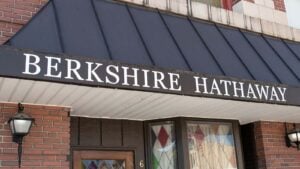As we put 2023 to bed, it is the right time to reflect on your portfolio and reorganize it for the year ahead. I’ll be upfront: 2024 does have risks as the economy continues to absorb repeated rate hikes from the Fed. However, as a long-term investor, I’ve learned that almost nothing disrupts quality companies over the long haul. I believe 2024 won’t be nearly as chaotic for stocks, and the worst may be behind us.
My optimism stems from indications that rate cuts could return in 2024 to spur growth, coupled with a tight labor market and steady GDP expansion. Many sturdy stocks are poised to capitalize as uncertainty fades. I’ll be spotlighting seven blue-chip names that should deliver appealing returns in the year ahead. I typically cover more under-the-radar, high-growth plays. But the core of your portfolio should consist of established, steadily growing companies with wide competitive moats. Let’s take a look!
Apple (AAPL)

If you analyze the portfolios of large hedge funds, you should quickly notice that Apple (NASDAQ:AAPL) is consistently a core holding for many top managers. Why is that? In my view, it comes down to unmatched quality and immense pricing power — two attributes investors eagerly award premium valuations for. And Apple delivers those spades.
Its tech hardware boasts some of the steepest margins across consumer electronics. Meanwhile, its community of devotees gladly shells out higher prices year after year for the latest iPhones, Macbooks, and accessories. This fan loyalty is especially evident among younger demos like Millennials and Gen Z. As they gain more discretionary income, I believe Apple is primed for enduring success. Its brand has become nearly synonymous with innovation and prestige.
Could Apple still innovate more rapidly? Sure. But its incremental improvements still compel upgrades while blue-sky projects percolate behind the scenes. For these reasons, I remain confident Apple has a bright future indeed. Its premium valuation is warranted. This cash cow will keep churning out new gadgets we can’t live without — and handsome returns for shareholders. And yes, the Apple Watch debacle is on my radar, but I don’t think American lawmakers will shoot their own foot by not giving Apple some leeway.
Berkshire Hathaway (BRK-A, BRK-B)

The value investor’s icon, Berkshire Hathaway (NYSE:BRK-A, NYSE:BRK-B), has continued growing; despite 2023 seeing Warren Buffett lose his decades-long right-hand man Charlie Munger, the market retains tremendous faith that the Oracle of Omaha’s creation can continue thriving.
And why shouldn’t it? Buffett has hand-picked a solid management team to eventually take up the reins. They can steward his vision, pursuing productive acquisitions and letting Berkshire’s vast holdings compound. Those holdings read like an all-star lineup of Buffett’s favorite blue-chips. From Apple itself to Coca-Cola (NYSE:KO) and American Express (NYSE:AXP) — these are best-of-breed industry leaders.
So even when Buffett steps back to focus on philanthropy in the coming years, I expect Berkshire’s profit machine to keep humming. Its mountain of cash can fund more deals while its stock picks should keep paying dividends, fueling book-value growth. Simply put, Berkshire looks positioned to drive wealth for many years post-Munger.
Meta Platforms (META)

Meta Platforms (NASDAQ:META) is one of 2023’s greatest comeback stories after plunging below $100 per share. I pounded the table on Meta for many months. And while my short-term outlook has cooled recently, I still like its prospects in 2024.
Yes, Meta made strategic missteps, from ballooning CAPEX to deteriorating ad targeting. But give innovators like Mark Zuckerberg enough runway, and radical bets like the metaverse and VR may transform computing.
It’s easy to view such futuristic projects as boondoggles, but I wouldn’t underestimate Meta’s ambition. Last quarter, the company posted 23% year-over-year revenue growth, which is evidence that it’s back on solid ground. Analysts forecast double-digit sales expansion annually through 2028, along with 100% EPS gains in that timeframe.
Moody’s (MCO)

Moody’s (NYSE:MCO) is one of the “Big Three” credit ratings giants that effectively form a triopoly. I prefer Moody’s to S&P Global (NYSE:SPGI) among the two publicly traded players. Its balance sheet remains pristine, and its recent performance edged out SPGI. This triopoly is unlikely to fracture anytime soon; credit ratings greatly influence debt markets.
When companies want to issue bonds or loans, they desperately need the blessing of Moody’s ratings. That imbues MCO with great pricing power. And coming off a 2022 dip, shares have mounted a resilient recovery, supported by 26% profit margins and 16% sales growth last quarter. Yes, growth should cool absent a recovery tailwind, but I like MCO’s recurring revenue and competitive advantages. It’s a key Wall Street cog — and a dividend payer too, yielding 0.8%.
Visa (V)

Visa (NYSE:V) shares half of the payments duopoly with Mastercard (NYSE:MA). Like Fitch, Moody’s and S&P forming a triopoly, Visa and MA have cooperated in a two-player industry for decades. Their global payment rails are supremely profitable and wouldn’t be easy to replicate. To me, Visa gets the slight edge for its dividend, while Mastercard wins on buybacks. But either delivers strong ownership merits.
Case in point: Visa posted 11% sales growth and 54% net margins — still expanding! The toll road for money flows, its network should keep driving sustainable double-digit earnings growth for years to come. And it returns excess cash to shareholders, with dividends rising 16 straight years. Visa yields just 0.8% but has greater room for payout hikes. Simply put, it’s a prototypical blue chip built to enrich investors.
PepsiCo (PEP)

This pick is about as archetypal a staple stock as they come: PepsiCo (NASDAQ:PEP). As I’ve noted before, PEP is the obvious choice when I mention consumer defensive names. While not a household basics purveyor per se, its snacks and beverages might as well be. They’re ubiquitous — almost unavoidable — when strolling down any store aisle.
Yes, PEP dipped about 10% off its peaks as markets corrected this year. But defensive demand for its products should drive a recovery in 2024, supporting its nearly 3% dividend. PEP boasts 51+ years of payout growth — a feat I expect to continue. Reliable sales and steady pricing power make PepsiCo a sleep-easy stock pick tailor-made for skittish environments. Set it and forget it.
Dollar General (DG)

Dollar General (NYSE:DG) is my top recovery idea on this list after plunging over 45% in 2023. Brick-and-mortar retail broadly struggled amidst inflation and recession fears. But I foresee greener pastures in 2024 as consumers regain spending power.
DG specifically should prosper if lower-income shoppers get relief. Analysts expect renewed revenue and earnings growth next year, thanks to DG’s sharp value focus. It’s projected 4.4% 2024 (company FY25) sales growth and further expansion thereafter make me optimistic. And unlike most discounters, DG pays dividends with a 1.7% yield — payouts, I think, will rise nicely if profits rebound as predicted. Analysts also see revenue growth at almost 6% in 2025 and over 7.6% in 2026. All told, DG looks poised for a major recovery toward its 2023 highs.
On the date of publication, Omor Ibne Ehsan did not hold (either directly or indirectly) any positions in the securities mentioned in this article. The opinions expressed in this article are those of the writer, subject to the InvestorPlace.com Publishing Guidelines.
